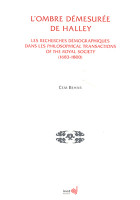
@@src2@@
L’ombre démesurée de Halley
Collection : Études et enquêtes historiques
2012, 256 pages
Préface par Jean-Marc Rohrbasser
Avant-propos
Introduction
Chapitre I - Études de population en Grande-Bretagne au XVIIIe siècle
Chapitre VIII - Pour conclure
Annexe 1 - Liste des mémoires sur la population publiés dans les Philosophical Transactions (1683-1800)
Annexe 2 - Reproduction en fac-similé d'un choix de mémoires
Bibliographie
Index
Avant-propos
Introduction
Chapitre I - Études de population en Grande-Bretagne au XVIIIe siècle
- Le corpus des mémoires de démographie dans les Philosophical Transactions of the Royal Society
- La Royal Society : fondation et modus operandi
- Analyse du corpus
- Edmund Halley et Henri Justel
- Le « programme de recherches » de Halley
- Empirisme et insularité
- L'attachement aux Bills of Mortality
- « What's in a name ? »
- Qu'attendait-on des tables de mortalité ? - une parenthèse
- Emprunts, annuités et compagnies d'assurance
- Tarifs, barèmes et risques
- Les dénombrements anglais et écossais
- Le réseau autour de Richard Price
Chapitre VIII - Pour conclure
Annexe 1 - Liste des mémoires sur la population publiés dans les Philosophical Transactions (1683-1800)
Annexe 2 - Reproduction en fac-similé d'un choix de mémoires
Bibliographie
Index
The very title of this book - Halley’s Colossal Shadow: Demographic Research in the Philosophical Transactions of the Royal Society - captures the essence of the thesis defended by its author: the two papers published in 1693 by the astronomer Edmund Halley laid the groundwork for a future population science, but also for its development by scholars of the Royal Society. Cem Behar rightly evokes a veritable "research programme" bequeathed by Newton’s colleague to his contemporaries and successors, and shows that this programme was never surpassed, but merely pursued.
We can safely say that throughout the eighteenth century, England was the European country which produced the largest number of studies and publications of all kinds relating directly or indirectly to population questions. Many were published in the Proceedings of the Royal Society. Among the papers featuring in the Philosophical Transactions of the Royal Society - the oldest scientific journal, still in publication today - Cem Behar has identified no fewer than 68 directly concerned with demographic issues over the period 1683-1800. They far outnumber the demographic papers contained in the Parisian journal l’Histoire de l’Académie Royale des Sciences.
In terms of volume, the papers constitute a corpus of more than a thousand pages of scientific texts, spread quite uniformly across the eighteenth century. In addition, the Royal Society - an institution founded by civil society and not under royal mandate - appears, on these questions at least, to echo the sentiments of enlightened British public opinion.
Cem Behar’s detailed analysis of these demographic papers published in Philosophical Transactions reveals a singular approach to political arithmetic and population studies, a standpoint very different from that prevailing on the continent at that time, be it in France, Germany or the Netherlands. The author shows clearly that eighteenth-century British authors tended to focus more on the calculation of rents, insurance and annuities, giving priority to financial and actuarial aspects rather than to population science per se.
We can safely say that throughout the eighteenth century, England was the European country which produced the largest number of studies and publications of all kinds relating directly or indirectly to population questions. Many were published in the Proceedings of the Royal Society. Among the papers featuring in the Philosophical Transactions of the Royal Society - the oldest scientific journal, still in publication today - Cem Behar has identified no fewer than 68 directly concerned with demographic issues over the period 1683-1800. They far outnumber the demographic papers contained in the Parisian journal l’Histoire de l’Académie Royale des Sciences.
In terms of volume, the papers constitute a corpus of more than a thousand pages of scientific texts, spread quite uniformly across the eighteenth century. In addition, the Royal Society - an institution founded by civil society and not under royal mandate - appears, on these questions at least, to echo the sentiments of enlightened British public opinion.
Cem Behar’s detailed analysis of these demographic papers published in Philosophical Transactions reveals a singular approach to political arithmetic and population studies, a standpoint very different from that prevailing on the continent at that time, be it in France, Germany or the Netherlands. The author shows clearly that eighteenth-century British authors tended to focus more on the calculation of rents, insurance and annuities, giving priority to financial and actuarial aspects rather than to population science per se.

